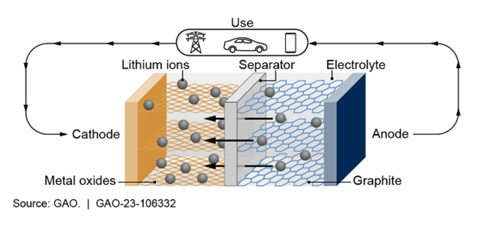Dangers of lithium ion batteries
About Lithium Ion Batteries
Lithium Ion Batteries power millions of devices each day. They are found in laptops and cell phones to hybrids and electric cars, and electric bikes. The technology is growing in popularity due to its light weight, high energy density, and ability to recharge--- they are the most popular and regularly used batteries in today's world.
The invention and commercialization of Li-ion batteries is considered as having one of the largest societal impacts in human history among all technologies,[10] as was recognized by 2019 Nobel Prize in Chemistry to to John B. Goodenough, M. Stanley Whittingham and Akira Yoshino.
How to Lithium Ion Batteries work
Note: Before reading about the Lithium battery you should understand the mechanism of how all batteries work... see How does a battery work.
Li-ion batteries consist mainly of four main components: cathode, anode, electrolyte, and separator.

In a lithium-ion battery, lithium ions (Li+) move between the cathode and anode within the battery.. Electrons move in the opposite direction in the external circuit. This migration is the reason the battery powers the device—because it creates the electrical current.
Li-ion batteries can use a number of different materials as electrodes. The most common combination is that of lithium cobalt oxide as the cathod and graphite as the anode.\
While the battery is discharging, the anode releases lithium ions to the cathode, generating a flow of electrons that helps to power the relevant device.
When the battery is charging, the opposite occurs: lithium ions are released by the cathode and received by the anode.
Why is Graphite used in Li Ion batteries?
\Graphite is the most commonly used to serve as the anode material in lithium-ion battery manufacturing due to its relatively low-cost and its energy density. Graphite has great conductive properties and for the most part is readily available.
The structure of graphite is such that it has a large number of electrons floating freely between the different layers of atoms (graphite bonds are formed of only three out of the four electron shells of the carbon atom, leaving the fourth electron to move freely).
Graphite is soft, chemically inert, and has high lubricity, stiffness, and thermal conductivity. Besides metal, graphite is the only material that can conduct electricity.
Why are Lithium Batteries Dangerous
"...Lithium-ion batteries can enter an uncontrollable, self-heating state. This can result in the release of gas, cause fire and possible explosion. Storage and charging more than 5 or more batteries must have a dedicated space... " source
Reignition of lithium-ion batteries is common. Lithium-Ion batteries are known to unexpectedly re-ignite (without warning) minutes, hours and even days after all visible fire has been put out.
Water may not prevent a battery from burning and spreading Fire Extinguishers do not work on lithium-ion batteries fires. If you observe a lithi-um-ion battery fire, leave the area, CLOSE the door, and call 911 immediately.
Sources and Readings
How to lithium ion batteries work --Energy.gov
Advanced Batteries -GAO.gov
Lithium Ion Batteries --Sandia Labs
Why does Graphite Conduct Electricity --- Science Focus
How does a battery work --Edinformatic.com
What Are Lithium-Ion Batteries? --UL Research Institutes
How Lithium Ion Batteries Work --Energy.gov
Electrode materials for lithium-ion batteries -- Science Direct
Dangers of Lithium-Ion Batteries --nyc.gov
-
Dangers in the Home